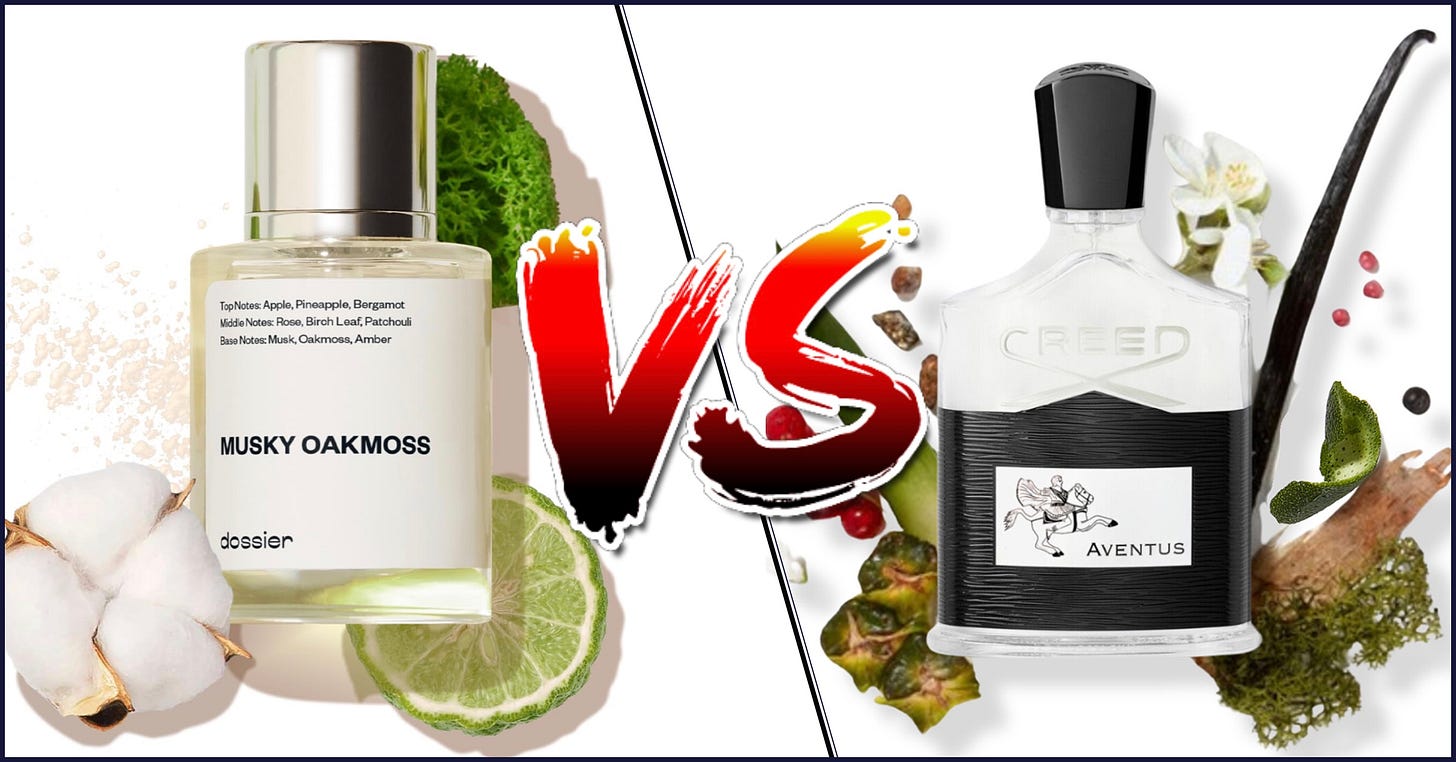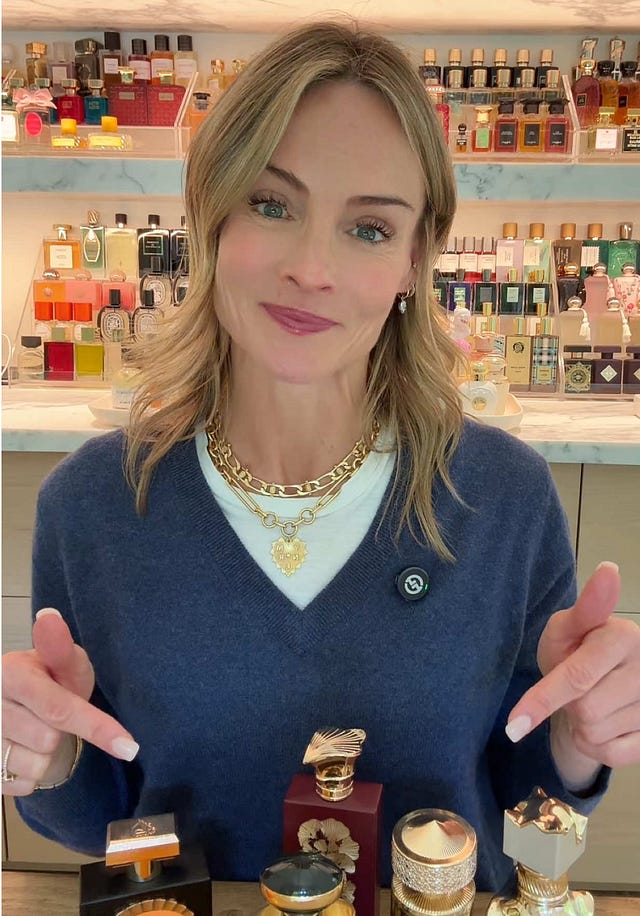Smells Like Fake Spirit?
Why Finding the Perfect Dupe Became More Valuable Than Owning the Original
When my FIT students ran a blind fragrance test comparing originals and their dupe, many respondents couldn't tell them apart and some even preferred the copy. Welcome to the dupe revolution: a $10 billion market by 2025, with nearly one-third of U.S. adults having intentionally purchased a dupe and two-thirds now associating duped brands with words like “fashionable”, “trendy” and even “elite”.
In this piece, I won’t be covering shady, back-alley counterfeits with health risks. This deep dive is about “safe” dupes from established brands like Dossier and Lattafa. These brands deploy gas chromatography to reverse-engineer high-end formulas, then openly reference the original’s name on Amazon. They’ve transformed from shameful secrets into social-media gold mines, where discovering a perfect match becomes content currency.
But here's the uncomfortable truth: dupes aren't just disrupting luxury, they're exposing its weak spots. When a generation raised on instant gratification meets skyrocketing luxury prices, the old rules of aspiration can break. The real question isn't whether dupes work, it's what happens to creativity when copying becomes more profitable than creating.
When the Copy Outperforms the Original
To cut through the hype, I gave my FIT students a simple assignment: pair an original fragrance with its dupe then have friends and family go through a blind test to note which one they preferred and why. The insights were revelatory:
Opening Blast vs. True Texture
Dupes often deliver a louder first impression because a powerful projection tends to convey value to uninitiated noses. This led participants to misidentify the dupe as original fragrance on first spray. Yet as fragrances dried down, originals revealed richer, deeper, more layered heart-note evolution and lasting complexity, while many dupes softened too abruptly.
High/Low Graduation?
Could dupes serve as a gateway to luxury? A hypothesis is that fragrance newcomers buy safe, budget-friendly alternatives to sample a variety of scent families before “graduating” to prestige or niche bottles as their tastes—and budgets—grow. It mirrors fashion’s high/low approach with customers splurging on Chanel ballet flats but wearing them with a pair of H&M jeans. A similar wardrobing we’re seeing happening in fragrances.
Are dupe actual creations?
Even though dupe brands leverage gas chromatography to match an original formula, they are not carbon copies. In students’ blind tests, participants noticed differences such as amped-up top notes and streamlined heart accords. Could this echo Duchamp’s three percent rule? Where minor edits transform an existing work into something new. Because, by identifying their audience’s scent preferences and incorporating these tweaks, dupe brands win over customers. Could we call these formulations actual creations? Personally, I believe they cross into a moral gray zone when they openly advertise the original fragrance’s name in their marketing. Imagine Zara or Shein selling a bouclé jacket and leveraging the “Chanel” brand inspiration directly on their PDP. A storm of cease-and-desist letters would follow!
How TikTok Turned Dupes Into Status Symbols
Soaring luxury prices have pushed buyers toward affordable options while social media’s bargain-hunting thrill pulls them down the rabbit hole. Together these twin forces have ignited the dupe phenomenon. Searches for luxury-brand dupes on Google jumped 2.7× between 2020 and 2024 (with an 8.9× surge for perfume knock-offs), while TikTok’s dupe hashtag has racked up over 6 billion views.
Accessibility as Innovation
“People don’t have the budget to move as fast as their FYP [this is where] dupes bring accessibility as an innovation”, explains Meredith Rojas, CMO of McCo Beauty. As fashion prices soared, fragrance emerged as a more attainable entry point into luxury leading then dupes to democratize that status signal. By offering affordable, smart alternatives with high perceived value, dupe brands keep established houses on notice and drive customers to click “buy.”Creator-Led Virality
Content creators reframed “copies” as coveted “dupes,” stripping away shame and guilt by turning the hunt for the perfect match into must-watch content. This normalization of dupe is how a brand like Lattafa, famed for its dupe lines, became the most rated brand on Fragrantica the last two years. An ecosystem fueled by side-by-side comparison videos, affiliate links and follower growth created a virtuous circle for influencers, platforms, and consumers alike. TikTok Shops put even more gasoline on the fire by closing the click-to-cart loop, customers don’t even have to browse Amazon to order their dupe.
When We Started Valuing Hacks Over Effort
“Dupes aren’t the disease, they’re the symptom”, argues Eric Briones, luxury expert and editor of Journal du Luxe. They expose self-inflicted wounds in luxury pricing and reveal a deeper cultural shift that undermines traditional notions of craftsmanship and authenticity.
Flight to Value
Luxury is built on aspiration but when price tags grow faster than quality then the dream shatters and perceived value collapses. Steep increases are breaking the customer’s relationship with luxury, eroding trust in brands. The risk is that flight to value drives shoppers away from higher price tags toward options that strike a better balance between cost and experience. Dupes meet that demand: a clear value proposition that resonates with shoppers.
The Decoupling of Work from Reward
We now live in an era where GLP-1s promise rapid weight loss, AI generates art at the click of a button and meme coins can mint overnight millionaires. In this context, the true status symbol is no longer the luxury item itself, but the thrill of discovering a $30 alternative that rivals a $200 original. As Ellyn Briggs, a brand analyst at Morning Consult, observes, "it's become a point of pride almost for young people to say, 'I found this dupe that's just as good as this more expensive product.'" These bragging rights now outweigh the value of time and effort poured into traditional product development. This reflects what Concept Bureau calls “The Big Decoupling”: a cultural shift where effort and reward have become disconnected. In a world that prioritizes speed, accessibility and clever hacks, the allure of savvy consumption eclipses the appreciation for creativity and craftsmanship. And when innovation is undervalued, creativity flattens, leaving consumers with an ever-blander set of choices.
Trapped in the Algorithm's Safe Zone
Dupes emerged from a culture of safe bets and then accelerated it. As brands retreat from risk and the algorithm rewards predictability, creativity stalls and consumers are left with increasingly bland offerings that fail to inspire. Each copy that succeeds reinforces the fear of innovation, trapping the industry in a self‑perpetuating loop.
Algorithmic Homogenization & Creative Freeze
Algorithms spotlight familiar content, steering feeds toward proven patterns: from Marvel sequels and TV spinoffs to cookie‑cutter Airbnb aesthetics. In fragrance, that means flankers, gourmand dominance and now dupe culture. The safest way to hedge your bets as a brand is to feed the algorithm’s appetite for sameness.Vicious Trend‑Cycle & Innovation Aversion
This creative freeze becomes a self‑preservation mechanism: the constant threat of dupes stifles experimentation and ensures that only the safest, most derivative scents make it to market because original creators bear all R&D costs only to see their work duplicated within weeks. As a result, many brands respond by retracing familiar paths instead of forging new ones.
Reversing this vicious circle depends on restoring consumer trust: the very relationship that dupes have eroded.
Why Perfume Needs to Dream Again
“Perfume is not just a scent” as Francis Kurkdjian reminds us in Fat Mascara. Fragrance transports us into dreams, stories and shared moments. This is why dupe are unsustainable: they lack heritage, emotion and the narrative moat that grants originals their lasting value.
Even dupe brands like Dossier have begun offering their own creations and even winning an Allure Best of Beauty Award for Sage & Black Tea Renew, underscoring that true brand success demands genuine innovation.
To rebuild aspiration and reclaim authenticity, fragrance brands must focus on:
Empathy
Meet shoppers without judgment. As Hermès CEO Axel Dumas reminds us, empathy and humility pave the path back to trust: acknowledge budget pressures and personal taste and show that luxury remains within reach for those who value it. Antagonizing customers for choosing dupes is not a strategy, fragrance houses must lead with understanding, not shame.
Education
showed our FIT students how Twisted Lily built thoughtful email flows to educate on dupes. Transparent education around sourcing, craftsmanship and pricing empowers customers to see and value the difference.
Help customers understand what sets originals apart. Guest speakerCommunity
, brands should partner with "community architects,” not just influencers, to foster peer-to-peer dialogue and belonging. This emotional bond becomes your brand’s moat, rooted not in exclusivity but in shared identity. It’s also how you rebuild the dream: by offering meaning, not just marketing.
Move beyond campaigns to connection. True communities grow through shared rituals and active participation. As community strategist Sara Wilson writes in
When the Tide Goes Out
The dupe phenomenon isn't just disruption, it's a wake-up call. Smart brands won't fight $40 copies. They'll focus on what dupes can't touch: the dreams that transform a scent into a story. Dupes are lifting the fragrance market by onboarding millions to the category. But as Warren Buffett warns, "It's after the tide goes out that we see who's naked". When the fragrance boom cools off, only brands that built authentic connections will survive.
The future belongs to those creating what gas chromatography can't reverse-engineer: belonging. That's where the real magic happens.








